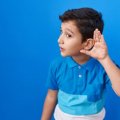Want to attract the opposite sex? Then bring on the fluoro colours, according to an international study published today in Science.
The study conducted at The University of Queensland by British and Australian scientists found that budgerigars showed a significant sexual preference for mates with fluorescent plumage.
"It`s the first demonstrated use of fluorescence in the animal kingdom, apart from humans," said Dr Justin Marshall of The University of Queensland`s Vision Touch and Hearing Research Centre.
Dr Marshall is co-author with Dr Kathryn Arnold of the University of Glasgow and Dr Ian Owens of Imperial College.
"For some time humans have used fluorescence as an attractant," he said. "We have fluorescent highlighters and post-it notes, washing powders which give white fluorescence to our clothes, some advertisers use fluorescent paints in their displays and there are now even fluorescent tattoos used in night clubs.
"We are currently interested in animal communication and how use animals use colours to talk to each other. An obvious choice is parrots, which are vibrantly coloured."
Dr Marshall said the researchers followed up an earlier Australian Museum study which found fluorescence in feathers of stuffed parrots. They wondered why this was so.
They conducted experiments among budgerigars with naturally-occurring yellow fluorescent plumage on their crowns and cheeks for courtship displays.
Birds were given a choice of two stimulus birds of the opposite sex, one retaining fluorescent plumage on their crown, and the other whose fluorescence was reduced with sunblock. This decreased the amount of UV needed for excitation.
The researchers found strong evidence for fluorescent sexual signalling among the parrots. Focal birds showed a significant sexual preference for fluorescent stimulus birds of the opposite sex. The scientists calculated that fluorescent plumage added 14 percent extra "chromatic signal" to the crown region, as perceived by the visual system of another budgerigar. They also found that neither male nor female birds showed a significant social preference for same-sex fluorescent plumage birds.
"The bottom line for budgies, and possibly other parrots, is that success in mating only comes if you literally glow," Dr Marshall said.
Last year Dr Marshall won the L`Oreal Art & Science of Colour Prize of 30,000 Euros (~A$ 50,000) in Paris for his research on colour vision and colour communication in reef fish. He hopes to pursue further studies of colour communication in the animal kingdom this year.
Media: For more information contact Dr Justin Marshall (07 3365 4071(w) email: justin.marshall@mailbox.uq.edu.au) or Jan King at UQ Communications (0413 601 248).
.jpg)



